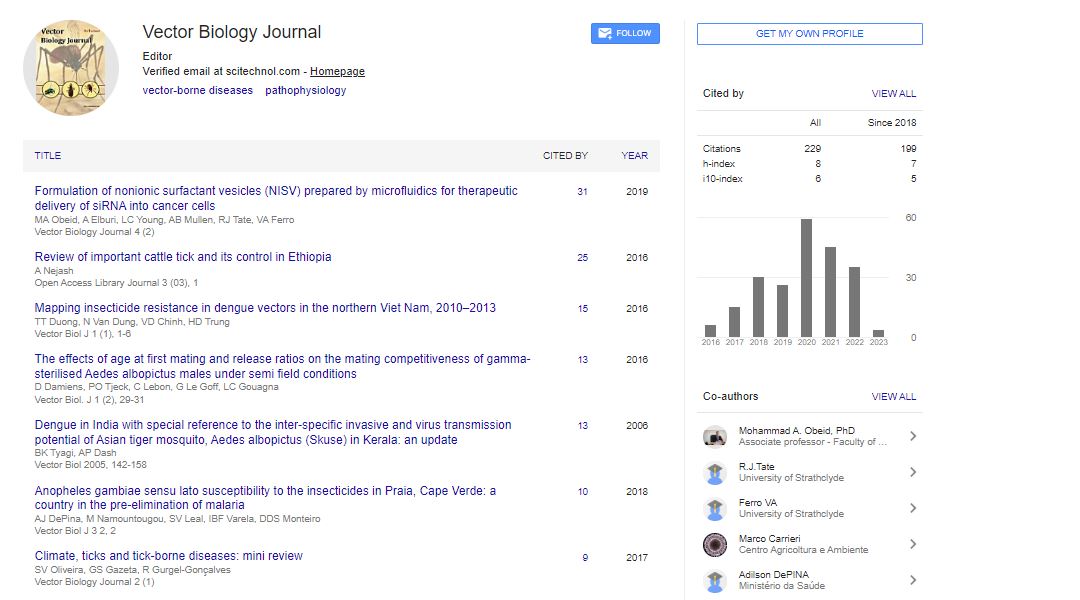Perspective, Vector Biol Vol: 8 Issue: 1
Arboviruses Infection: Diagnosis Treatment and Prevention
Suya Saita*
1Applied Life Science Department, Sojo University, Kumamoto, Japan
*Corresponding Author: Suya Saita
Applied Life Science Department, Sojo
University, Kumamoto, Japan;
E-mail: suyasaita@gmail.com
Received date: 20-Feb-2023, Manuscript No. VBJ-23-93748;
Editor assigned date: 22-Feb-2023, PreQC No. VBJ-23-93748 (PQ);
Reviewed date: 09-Mar-2023, QC No VBJ-23-93748;
Revised date: 16-Mar-2023, Manuscript No. VBJ-23-93748 (R);
Published date: 23-Mar-2023, DOI: 10.4172/2473-4810.1000253
Citation: Saita S (2023) Arboviruses Infection: Diagnosis Treatment and Prevention. Vector Biol 8:1.
Description
Dengue and Chikungunya viruses are arboviruses that are arboviruses that inhabit common aedes mosquito vectors and have identical endemicity. These two viruses also have similar clinical manifestations, particularly in the early stages of infection, with neither virus having any distinguishing clinical features. Because the outcomes and management strategies for these two viruses are so dissimilar, accurate and timely diagnosis is critical. Diagnosis is also important for surveillance, outbreak control, and vaccine and drug development research. The diagnostic tests available are designed to detect the virus, its antigenic components, or the host immune antibody response. Both viruses are arthropod-borne viruses (arboviruses) that share a common vector: Aedes mosquitos, specifically Aedes aegypti and Aedes albopictus. Both viruses are found in similar geographical areas. Travel-associated infections are an important consideration in nonendemic regions for patients with a recent travel history who present with fever.
Concurrent infection with both viruses is possible and can be transmitted by either two different mosquitoes or by a single, dually infected mosquito. Transmission of DENV has also been reported through contaminated blood products, organ donation, and prenatal and/or perinatal vertical transmission. RT-PCR with primers designed for structural and nonstructural domains has been found to be useful in CHIKV diagnosis. The combination of RT-PCR and nested PCR has proven effective for CHIKV detection and genotyping. Loop- Mediated Isothermal Amplification (LAMP) assays can be performed quickly in a water bath at a single temperature with visually detectable results and sensitivities comparable to conventional PCR. Testing urine samples with real-time RT-PCR provides a wider detection window that extends well beyond the viremia period; DENV RNA can be detected in urine up to day 16, whereas blood specimens can only be tested on day 8. The ability to test urine and saliva is useful in patients who cannot obtain blood samples, such as newborns and patients with hemorrhagic syndromes. Laboratory testing is required to confirm DENV or CHIKV infection.
When antibodies are not detected, molecular assays are more sensitive for diagnosis in the early stages of illness (2-5 days after onset). However, the sensitivity of molecular methods decreases in the later stages of illness due to the onset of a rapid immune response and a corresponding reduction in viral load. The IgM ELISA is a more sensitive diagnostic test at this stage. An ideal diagnostic test meets several key criteria, including affordability for those at risk of infection, specificity, sensitivity, ease of use, rapid results, minimal reliance on equipment, and delivery to those in need.
The ideal test would also include a multiplexed assay for other pathogens that cause acute, undifferentiated fever, such as malaria. Diagnostic testing for DENV and CHIKV has advanced. High sensitivity and specificity tests, in general, necessitate more complex technologies and technical expertise, whereas rapid tests may sacrifice sensitivity and specificity for the benefits of speed and ease of performance. It is difficult to strike a balance between diagnostic method accessibility and test result confidence. In rural areas, antigen detection assays appear to be the most promising for rapid and early diagnosis. In this regard, DENV diagnostic tests have advanced ahead of those for CHIKV, but both of these arboviruses are clearly important causes of disease in their shared endemic regions and in travellers to these areas.
 Spanish
Spanish  Chinese
Chinese  Russian
Russian  German
German  French
French  Japanese
Japanese  Portuguese
Portuguese  Hindi
Hindi 